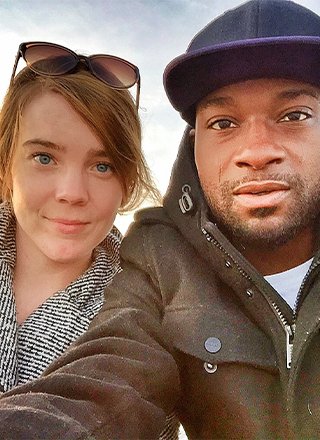Editor’s Note: 2022 marks the 75th anniversary of the founding of Americans United for Separation of Church and State. To celebrate this milestone anniversary, Church & State will be profiling important figures in the life of the organization throughout the year. This month, we’re featuring Glenn L. Archer, the first executive director of Americans United.
Many people in Kansas were convinced that Glenn L. Archer was headed for something big in the world of politics.
During the 1940s, Archer, who had grown up in rural western Kansas, was making a name for himself all over the state. As a representative of Kansas Gov. Payne Ratner, Archer crisscrossed the plains, speaking at school commencement ceremonies, meeting with education officials and solving problems. Known for his powerful speaking style, Archer was a compelling and charismatic figure. Many in the state thought he would be governor himself one day or perhaps go to Washington, D.C., and serve in the U.S. Senate.
Archer did end up with a high-profile public career, one that put him in the center of many political controversies and catapulted him to the national stage, but he never held public office. Instead, he spent nearly three decades leading Americans United for Separation of Church and State, a new national organization founded in 1947 to shore up the church-state wall.
The Supreme Court in 1947 had handed down an important ruling in a church-state case called Everson v. Board of Education. Although the high court endorsed church-state separation in the ruling, it also approved taxpayer funding for bus transportation to parochial schools. (See “A ‘High And Impregnable Wall,’” February 2022 Church & State.) At the same time, issues over the proper role of religion in public schools were surfacing in the courts; and controversies over access to birth control, which conservative religious groups had succeeded in making illegal, were roiling many states.
Alarmed at these breaches of the church-state wall, several national religious and civic leaders called for the creation of an organization that would focus exclusively on defending the Constitution’s promise of distance between religion and government. They met in Chicago late in 1947 and issued a manifesto announcing the creation of Americans United.
The structure was in place, and an action plan had been outlined. These leaders just needed someone to take the reins. That’s where Archer came in.
Ironically, Archer never sought the top slot at AU; he was recruited into it. In 1948, about six months after the group had been founded, Archer, who was then serving as dean of Washburn Law School in Topeka, traveled to Washington for a legal conference. While there, he was approached by Dr. J.M. Dawson, executive director of the Baptist Joint Committee on Public Affairs, who offered him the AU top position.
Archer, who didn’t know Dawson, recalled later that he was taken aback. Dawson had received a host of positive reports about Archer and just assumed the Kansan would take the job, but Archer wasn’t convinced. While he was a strong supporter of church-state separation, he knew that AU was just getting launched; and he wasn’t sure he wanted to leave an established position in his home state for an organization that might not take off.
But Dawson was persistent, and in July 1948 Archer accepted the offer and moved to the D.C. area with his wife and two children.
In his 1982 memoir, The Dream Lives On (written with Albert J. Menendez), Archer recalled that fateful decision.
“Come what may, I had made my decision,” Archer recalled. “Those who prize security, position, and political prestige will never understand my coming to this post. Governor Ratner, my former chief, expressed his regrets at my giving up ‘so bright a future’ in traditional and less criticized endeavors. But I mused: Why did Horace Mann leave his lucrative law practice and brilliant political future to become a secretary of a school board at low pay? Because he regarded the cause of education more highly than his own personal advancement. The day I decided to accept this assignment, Horace Mann’s noble charge kept running through my mind, ‘Be ashamed to die until you have won some victory for humanity.’ I believe something of his spirit and vision moved me to join AU.”
Archer’s first tasks were to find a home for Americans United and build up its staff. At the time, Archer’s “office” was a desk in a building that housed the Baptist Joint Committee, and Archer and a secretary were the only staff members. That would soon change.
In those early years, AU was anchored in several Protestant churches and enjoyed strong relationships with Baptists and other faith communities. But the organization was never meant to be an arm of any specific denomination, and it was essential to establish its independence by finding its own home.
By the end of 1948, Archer had secured rented space for AU on K Street, in the heart of D.C. But Archer continued raising money for a building, and in 1949 the organization had enough to buy its own headquarters on Massachusetts Avenue.
Even as he was raising funds for AU’s first home, Archer had to tend to tasks such as hiring staff, arranging events and planning a strategy to put the new group on the map. In 1949, AU held its first national conference on church and state. It was a hit. In fact, the following year, more than 4,000 people crammed into Constitution Hall to hear Archer speak at the second annual conference.
Archer also oversaw the creation of AU’s membership organ. Originally titled Church & State Newsletter, the publication was issued bimonthly for a year but became a monthly in 1949. (Its name was later shortened to Church & State.) In an age when television was still a novelty, a print magazine was the primary way AU communicated with its supporters, shared information and gave them ammunition to defend church-state separation.
The professional departments Archer created and managed looked a lot like they do today: Archer hired lobbyists to go to Capitol Hill and work with members of Congress. He understood the need for grassroots activism, so he created a department to organize people in their own communities and form chapters of Americans United. Attorneys were hired to litigate cases and file briefs.
Eager to spread the word about Americans United, Archer found people skilled in public relations to tell the story of AU and the story of how church-state separation developed in America. He hired fundraisers to ensure AU would remain financially secure. Accountants balanced the books and kept a careful eye on cash flow.
Archer also undertook outreach to religious, educational and fraternal communities. Unlike several executive directors who followed him, Archer was not an ordained member of the clergy. But he had strong credibility in religious communities. A Free Methodist, Archer held an “exhorter’s license,” a status that allowed him to preach in churches and conduct funerals.
Not everyone was pleased to see the sudden appearance of a group committed to defending church-state separation on the national stage. Christian nationalism wasn’t the powerful political movement it is today, but the hierarchy of the Roman Catholic Church often butted heads with AU. Church leaders sought taxpayer support for its network of private religious schools, worked to ban artificial birth control and advocated for censorship of books, films and other materials they believed cast religion in a poor light – all stands AU opposed.
These battles were spirited, and the church hierarchy sometimes accused Archer of anti-Catholicism. It was highly ironic, therefore, in 1960 when Archer found himself defending John F. Kennedy against the clergy of Kennedy’s own church. During his presidential campaign, Kennedy had vowed to oppose tax funding of religious schools, a stance he emphasized in an exchange of letters with Archer. Kennedy’s position angered the church hierarchy, but Archer pointed out that it was in line with the Constitution. (Kennedy, Archer declared in his memoir, was the strongest president on church-state separation since Thomas Jefferson and James Madison.)
Opposition to vouchers, tax credits and other forms of government aid to religious schools consumed much of AU’s time during the 1960s and ’70s. Archer kept a heavy speaking schedule and frequently appeared in the media.
Over the years, other issues became prominent as well. In the late 1940s and ’50s, AU helped litigate against so-called “captive schools.” Under this system, public schools in some rural areas of the country were turned over to religious groups, which ran them as de facto religious institutions. AU’s advocacy helped put a stop to the practice.
Government-mandated school prayer and Bible reading also became hotly contested issues. When the Supreme Court struck down these practices in 1962 and ’63, Archer made sure Americans United took the stand that these state-sponsored religious exercises were a violation of religious freedom. In the wake of those rulings, several efforts were launched in Congress to amend the Constitution to “restore” school prayer. Archer led Americans United in opposing every one of them.
Under Archer’s tenure, AU supported legal abortion and welcomed the Supreme Court’s 1973 ruling in Roe v. Wade, arguing that Americans’ health care choices should not be governed by theology. It was a natural extension of the group’s work in supporting access to birth control in the face of entrenched religious opposition.
Not all members of AU’s coalition were pleased by these stands, and during the social upheaval of the 1960s, some theological conservatives drifted away. By the time Archer retired in 1976, the organization had long since stopped referring to itself as Protestant. Although non-Christians and people of a secular bent had always been involved with AU, they became more prominent in the late 1970s and ’80s.
When Archer retired, he was pleased to receive a letter of commendation from President Gerald R. Ford. The GOP had been Archer’s political home all his life. He was well connected with the Republican Party; indeed, at this point, prior to the rise of the Religious Right, AU enjoyed vigorous support from many in the GOP.
In retirement, Archer often spent time at a farm he owned in West Virginia, where he enjoyed riding horses. In 1997, AU’s 50th anniversary, he was interviewed for a video, offering his recollections of Americans United’s early days. He was 91 at the time.
Archer died on Nov. 15, 2002. He was 96.
The Rev. Barry W. Lynn, who served as AU’s executive director at the time, issued a statement:
“Glenn Archer was a figure of towering energy and intellect,” Lynn said. “During his professional career, he interacted with presidents, U.S. senators and leaders of national religious denominations. But he never forgot that Americans United was created to protect the religious liberty of the average person and to be a voice for those who would otherwise have no influence in the nation’s capital.
“These principles – religious freedom for all and a fierce determination to stick up for the rights of the underdog – guided his tenure,” Lynn continued. “Thanks to Dr. Archer’s vision and hard work, Americans United was established as a permanent presence in American life and has built a reputation as a strong defender of religious liberty through the separation of church and state.”


